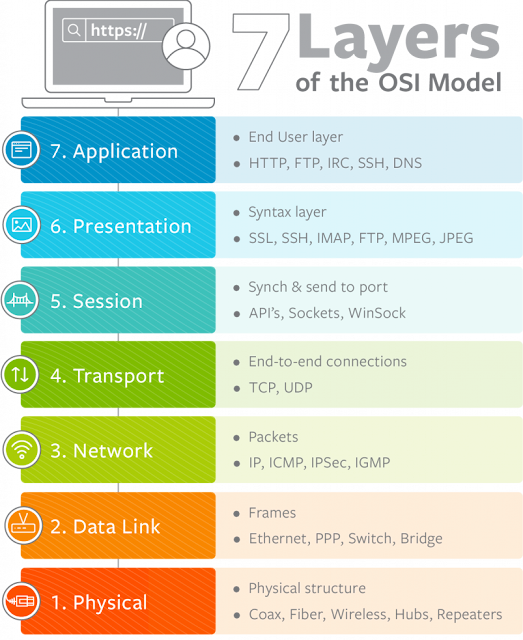How Network Communications Occurs? | OSI Model.
Today, In this blog we are talking about How Network Communication occurs with the OSI Model.
First, the OSI Model Stands for Open Sytems Interconnection.
The OSI model is a conceptual model of how network communication occurs. For network communication to happen, the layers must work together to transmit a message from one device to another.
There are 7 layers in the OSI model. We'll start at the top-most layer, layer 7, and work our way down to layer 1.
Layer 7 - Application
Layer 6 - Presentation
Layer 5 - Session
Layer 4 - Transport
Layer 3 - Network
Layer 2 - Data Link
Layer 1 - Physical
The OSI model is a breakdown of the various aspects of network communication. It is concerned with the ability of different systems to be connected with each other. It's a conceptual breakdown of all the parts that are involved and groups them into logical sections. Let's check them out.
This above image will help you to understand which concepts are there in the OSI model.
The information that goes along with the OSI Model is vast and deep, and we're not going to go into more detail on the standards and protocols than we have right here. I just want you to be aware of another aspect of the OSI model and to see from another perspective how it is a conceptual model to help group information.
First, the OSI Model Stands for Open Sytems Interconnection.
The OSI model is a conceptual model of how network communication occurs. For network communication to happen, the layers must work together to transmit a message from one device to another.
There are 7 layers in the OSI model. We'll start at the top-most layer, layer 7, and work our way down to layer 1.
Layer 7 - Application
Layer 6 - Presentation
Layer 5 - Session
Layer 4 - Transport
Layer 3 - Network
Layer 2 - Data Link
Layer 1 - Physical
The OSI model is a breakdown of the various aspects of network communication. It is concerned with the ability of different systems to be connected with each other. It's a conceptual breakdown of all the parts that are involved and groups them into logical sections. Let's check them out.
This above image will help you to understand which concepts are there in the OSI model.
The information that goes along with the OSI Model is vast and deep, and we're not going to go into more detail on the standards and protocols than we have right here. I just want you to be aware of another aspect of the OSI model and to see from another perspective how it is a conceptual model to help group information.
Sibling Dependence
In the OSI model, The layer is always concerned with above and below to layer to transmit the information.
For Ex: Suppose in layer 2(the Data Link). when a data comes from top to bottom then they layer 2(the Data Link) always concerned from top layer 3(the Network Layer) and then they move data to layer 1(the Physical layer).
As same, when data goes bottom to top then layer 2(the Data Link) always concerned from layer 1(the Physical layer) and after that the layer 2(the Data Link) is moving top to layer 3(the Network Layer).
Layer 7 (the Application layer) is at the very top of the OSI model. Since it is at the top, it is only concerned with sending data to Layer 6 (the Presentation layer) or receiving data from Layer 6.
The Single layer doesn`t need to know the whole path of data, It Just needs to know to the above and below layer. So Each Layer is Abstract Layer(a way of hiding the working details of a subsystem) in the OSI model.
For example, the way that the data is formatted, processed, and changed in Layer 2 does not matter to Layer 4, because of Layer 3 abstracts those implementation details away. All Layer 4 has to worry about is how it needs to receive data from Layer 3 - it doesn't have to worry about the specifics of Layer 2 (since that's Layer 3's job).
Encapsulation and Decapsulation
Remember that the OSI model is a conceptual model of how data is packaged and sent across a network to another device. In this scenario, let's assume that there are only two devices that are trying to communicate with each other. The OSI model is used on both devices.
As the data is being packaged up on a sending device, the data moves down the OSI model; this process of the data moving down the OSI model is called encapsulation(watch Video).
When the data is being unpacked on a receiving device, the data moves _up_ OSI model; this process of the data moving up the OSI model is called decapsulation(watch Video).
Network Transmission
As see how data a transfer to a network or received from the network, In encapsulation we have to receive data in our physical devices, Decapsulation is occurring when data are transmitted to the network.
Let us see how these above things work rapidly and continuously in this video.
Note: Above all videos is taken from "Udacity" videos because they teach that topic in proper manner.
Let us see how these above things work rapidly and continuously in this video.
Note: Above all videos is taken from "Udacity" videos because they teach that topic in proper manner.



Comments
Post a Comment